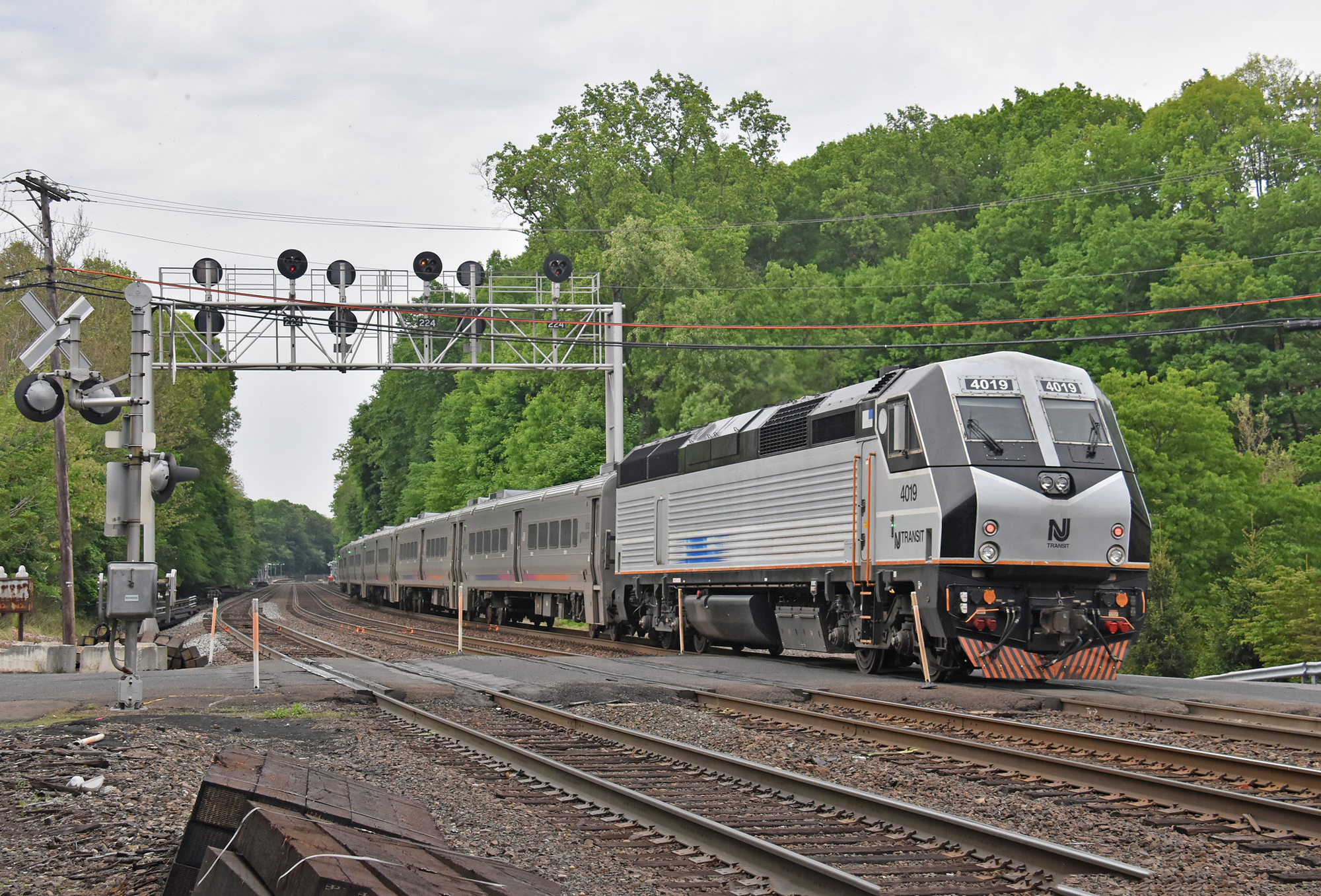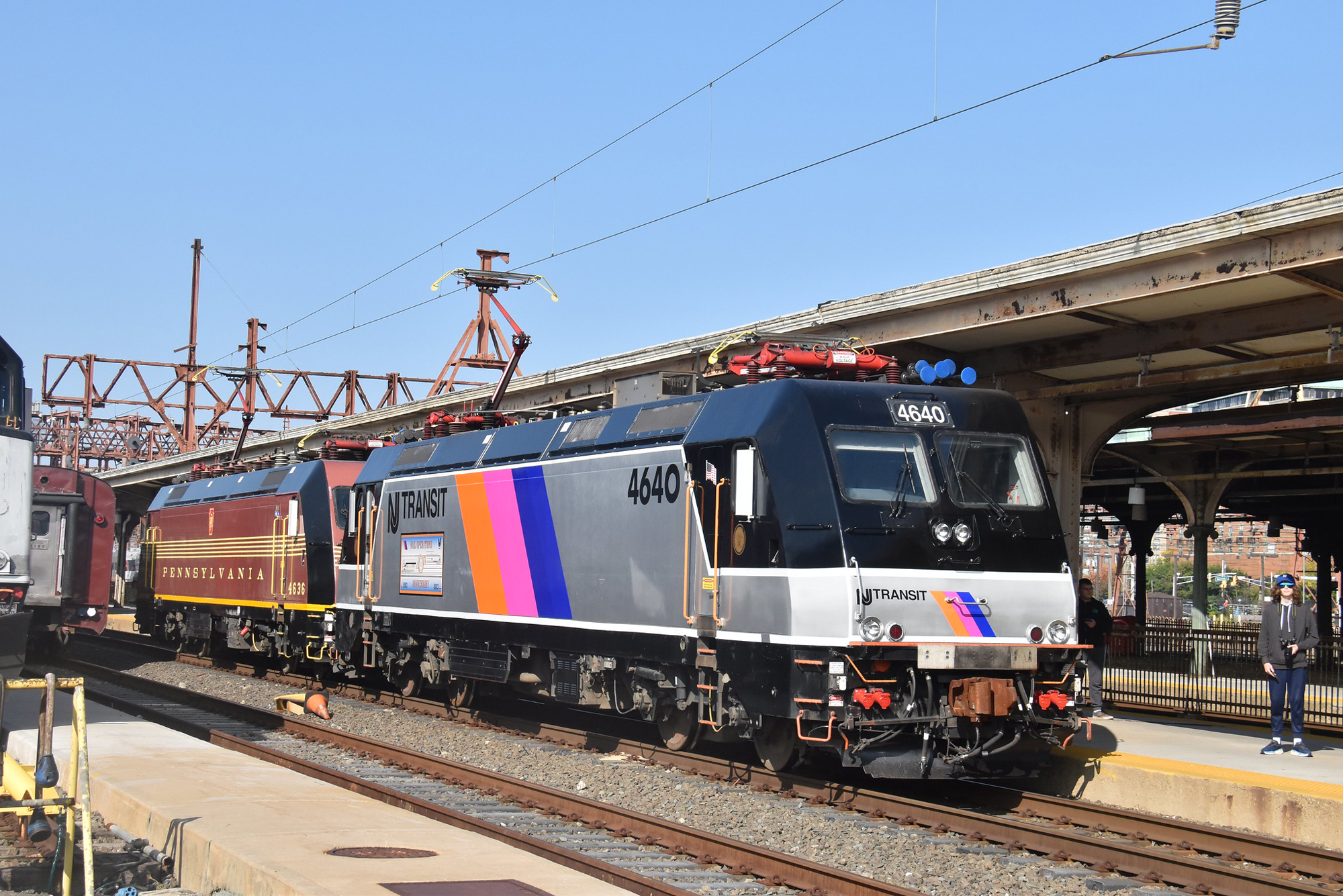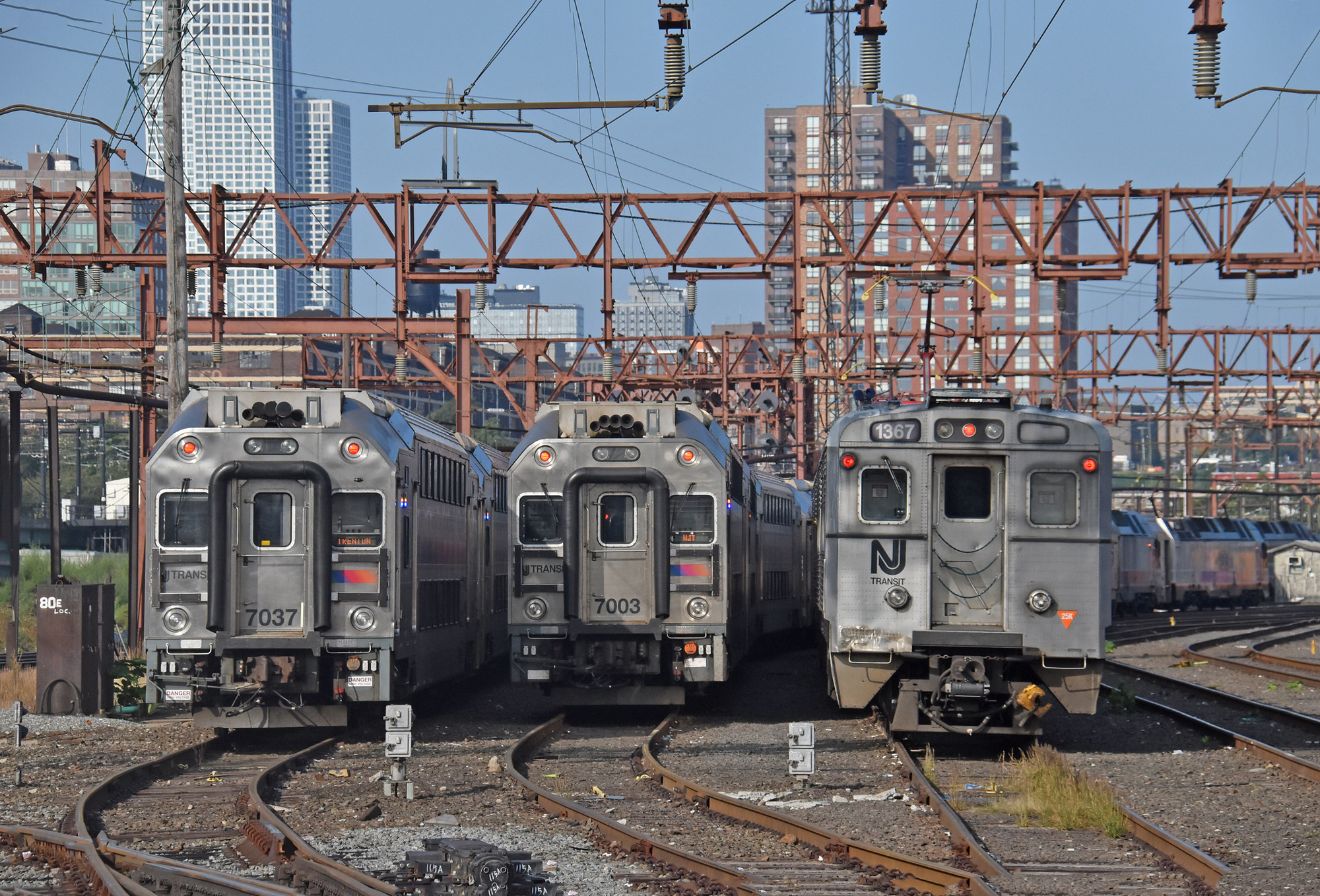NJ Transit: A Guide To New Jersey's Commuter Rail System
Last revised: September 6, 2024
By: Adam Burns
NJ Transit, also known as New Jersey Transit, is the primary public transportation system serving the state of New Jersey. It operates commuter rail, light rail, and bus services across the state and into neighboring New York and Pennsylvania.
This guide will delve into the details of NJ Transit’s commuter rail operations, offering you an in-depth look at its history, services, routes, schedules, and tips for navigating the system efficiently.
 NJ Transit PL42AC #4019 is pushing a eastbound train on the old Erie Railroad main line at Ho-Ho-Kus, New Jersey on May 13, 2023. Doug Kroll photo.
NJ Transit PL42AC #4019 is pushing a eastbound train on the old Erie Railroad main line at Ho-Ho-Kus, New Jersey on May 13, 2023. Doug Kroll photo.Origins
NJ Transit, formally known as New Jersey Transit Corporation, has a rich history rooted in the evolution of public transportation in New Jersey.
The organization was born out of necessity when the state of New Jersey recognized the challenges faced by the transportation network, which included dilapidated infrastructure, financial instability, and declining service quality after private railroad companies struggled with operational viability. Service officially launched on July 17, 1979.
Before its formation, New Jersey’s commuter rail services were primarily managed by private railroads like the Pennsylvania, Central Railroad of New Jersey, and Erie Lackawanna Railway.
These companies faced severe financial difficulties in the mid-20th century, leading to service cutbacks and deferred maintenance. The creation of Amtrak in 1971 addressed some intercity rail challenges, but suburban commuters were still underserved.
In response, NJ Transit was established by the New Jersey Legislature, taking control of the failing commuter rail services inherited from the Conrail operations in 1983.
This transition was part of a broader effort to revitalize the state’s public transportation network and integrate bus, rail, and light rail services under a single umbrella.
Significant investments were made into modernizing the fleet, renovating stations, and expanding services to meet the growing transportation demands of an increasing suburban population.
Throughout its history, NJ Transit has continued to evolve and expand. It introduced new rail lines and increased connectivity, including significant projects like the Midtown Direct service in 1996, which allowed trains from New Jersey to run directly into New York Penn Station — dramatically reducing travel times.
Furthermore, significant efforts were invested in infrastructure improvements and safety enhancements, including the implementation of Positive Train Control (PTC) systems.
Today, NJ Transit stands as the nation's third-largest provider of commuter rail services, operating 12 lines across 1000 miles, serving as a vital link for commuters traveling between New Jersey, New York, and Pennsylvania.
It continues to adapt to new challenges and strives to provide reliable, efficient, and safe transportation for millions of passengers annually.
 NJ Transit ALP-46A #4640 and #4636 - the latter wearing a special Pennsylvania Railroad livery - is on display at Hoboken, New Jersey on October 1, 2023. Doug Kroll photo.
NJ Transit ALP-46A #4640 and #4636 - the latter wearing a special Pennsylvania Railroad livery - is on display at Hoboken, New Jersey on October 1, 2023. Doug Kroll photo.Mission
With a mission to provide high-quality, reliable, and convenient services, NJ Transit serves as a critical link for millions of commuters and travelers. It ensures connectivity not only within New Jersey but also to major urban centers like New York City and Philadelphia.
Operations
NJ Transit operates 12 commuter rail lines spanning more than 1000 miles, with approximately 166 stations. In 2023 it saw total ridership of 209,259,800 (including bus, light rail, and commuter rail), making it the nation's third-largest commuter rail system.
Commuter Rail Lines
1. **Northeast Corridor Line (NEC)**
- **Route**: The NEC line runs from Trenton to New York Penn Station, passing through key towns such as Princeton Junction, New Brunswick, and Newark.
- **Service**: Known for its high-frequency service, it serves as a vital link between New Jersey and New York City, catering to a large number of daily commuters.
2. **North Jersey Coast Line (NJCL)**
- **Route**: Extending from Bay Head to New York Penn Station (or Hoboken), this line winds through picturesque coastal towns including Long Branch and Red Bank.
- **Service**: The NJCL is popular among beachgoers and vacationers in addition to daily commuters.
3. **Raritan Valley Line (RVL)**
- **Route**: From High Bridge to Newark Penn Station, with key stops in Bound Brook, Somerville, and Cranford.
- **Service**: Known for weekday peak service extending to New York Penn Station.
4. **Morris & Essex Lines (M&E)**
- **Route**: The M&E lines split into the Morristown Line from Hackettstown to New York Penn Station and the Gladstone Branch from Gladstone to Hoboken.
- **Service**: Offers reliable service to affluent suburbs and picturesque towns west of Newark.
5. **Montclair-Boonton Line (MLB)**
- **Route**: Running from Hackettstown and Montclair State University to Hoboken and New York Penn Station.
- **Service**: Serves key suburban areas and provides peak-directional service in and out of New York City.
6. **Main/Bergen County Line**
- **Route**: Extending from Suffern, NY, to Hoboken, passing through towns like Ridgewood and Paterson.
- **Service**: Connects commuters in northern New Jersey with vital transit hubs.
7. **Port Jervis Line (PJ)**
- **Route**: Running from Port Jervis, NY, to Hoboken, shared with Metro-North Railroad.
- **Service**: Primarily serves long-distance commuters from northwest New Jersey and southern New York State.
8. **Pascack Valley Line (PVL)**
- **Route**: From Spring Valley, NY, to Hoboken, with critical stops at Oradell and Woodcliff Lake.
- **Service**: Offers weekday peak service with convenient connections to Manhattan.
9. **Atlantic City Line (ACL)**
- **Route**: Runs from Philadelphia’s 30th Street Station to Atlantic City.
- **Service**: Popular among tourists and gamblers, it connects two vibrant metropolitan areas.
10. **Meadowlands Rail Line**
- **Route**: Provides special-event service directly to the Meadowlands Sports Complex from Hoboken, Secaucus Junction, and other lines
- **Service**: Operates only during major events, such as football games and concerts.
Ticketing and Fares
Types of Tickets
- **One-Way Tickets**: Single trip between any two stations.
- **Round-Trip Tickets**: Two one-way trips, discounted compared to buying two single trips separately.
- **Monthly Passes**: Unlimited travel between specified zones for one month, offering substantial savings for regular commuters.
- **Weekly Passes**: Unlimited travel between specified zones for one week.
Purchase Options
- **Mobile App**: NJ Transit offers a mobile app for purchasing and displaying tickets.
- **Ticket Vending Machines**: Available at most major stations.
- **Ticket Offices**: Located at larger stations, such as Newark Penn, New York Penn, and Hoboken.
- **Online**: Tickets and passes can be purchased through NJ Transit’s official website.
Schedules and Service Information
Peak and Off-Peak Hours
- **Peak Hours**: Monday to Friday mornings and evenings when commuter traffic is highest. Fares are generally higher.
- **Off-Peak Hours**: All other times, including weekends and holidays, with discounted fares.
Service Alerts
- **Real-time Updates**: Available through the NJ Transit mobile app, Twitter feeds, and website. Critical for staying informed about delays or cancellations.
- **Electronic Boards**: Located at major stations, providing live updates on train status.
Key Stations and Facilities
1. **Newark Penn Station**
- **Facilities**: Shopping, dining, and extensive transit connections including Amtrak, PATH, and light rail.
- **Importance**: Major transit hub for New Jersey commuters, providing access to NEC, NJCL, RVL, and other lines.
2. **New York Penn Station**
- **Facilities**: Extensive amenities including dining, shopping, and connections to Amtrak, LIRR, and subway lines.
- **Importance**: Primary destination for many NJ Transit commuters, facilitating easy access to Manhattan.
3. **Hoboken Terminal**
- **Facilities**: Restaurants, shops, and connections to PATH, ferries, and light rail.
- **Importance**: Key terminus for several commuter rail lines and a gateway to lower Manhattan.
4. **Secaucus Junction**
- **Facilities**: Modern amenities including retail, food, and convenient cross-platform transfers between lines.
- **Importance**: Major transfer station allowing seamless movement between different NJ Transit lines.
Key Tips for Travelers
1. **Plan Ahead**: Check schedules and purchase tickets in advance. Use the mobile app for convenient updates and ticketing.
2. **Arrive Early**: Especially during peak hours, arriving at the station early can help secure a seat and avoid the rush.
3. **Stay Informed**: Subscribe to service alerts for real-time updates on delays, cancellations, or other issues.
4. **Understand Fare Zones**: Familiarize yourself with NJ Transit’s fare zones to calculate costs and potential savings on passes.
5. **Utilize Park and Ride**: Several stations offer park-and-ride facilities for those driving from farther locations, providing convenience and savings on parking in urban centers.
6. **Safety and Etiquette**: Follow safety guidelines, be mindful of fellow commuters, and adhere to etiquette for a pleasant travel experience.
Future Developments
NJ Transit continues to invest in infrastructure and service improvements. Upcoming projects include:
1. **Portal Bridge Replacement**: Modernizing this key structure will improve reliability and capacity along the Northeast Corridor.
3. **Station Renovations**: Upgrades to facilities at key stations like Newark Penn, Hoboken, and others.
4. **Fleet Modernization**: Acquisition of new rail cars and locomotives to enhance comfort and efficiency.
 NJ Transit trainsets rest for the weekend at the Hoboken Terminal on October 1, 2023. Doug Kroll photo.
NJ Transit trainsets rest for the weekend at the Hoboken Terminal on October 1, 2023. Doug Kroll photo.Conclusion
NJ Transit’s commuter rail network is a critical element of the transportation infrastructure in New Jersey, providing extensive connectivity and reliable service to millions of travelers each year.
Whether you're a daily commuter or an occasional visitor, understanding how to navigate the system, being aware of ticketing options, and keeping informed about schedules and service alerts will enhance your travel experience.
With its historical significance and ongoing commitment to improvements, NJ Transit remains a cornerstone of public transit in the region.
Recent Articles
-
Arizona - Wine Tasting - Train Rides
Dec 24, 25 10:53 AM
For those who want to experience the charm of Arizona's wine scene while embracing the romance of rail travel, wine tasting train rides offer a memorable journey through the state's picturesque landsc… -
Arkansas - Wine Tasting - Train Rides
Dec 24, 25 10:50 AM
This article takes you through the experience of wine tasting train rides in Arkansas, highlighting their offerings, routes, and the delightful blend of history, scenery, and flavor that makes them so… -
Wisconsin - Wine Tasting - Train Rides
Dec 24, 25 10:40 AM
Wisconsin might not be the first state that comes to mind when one thinks of wine, but this scenic region is increasingly gaining recognition for its unique offerings in viticulture.



